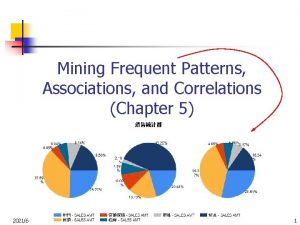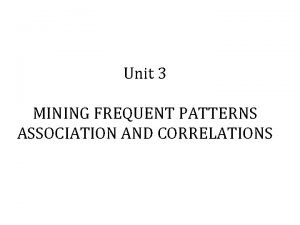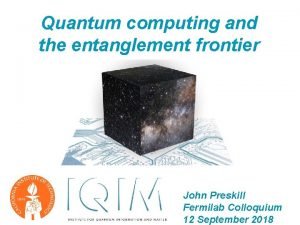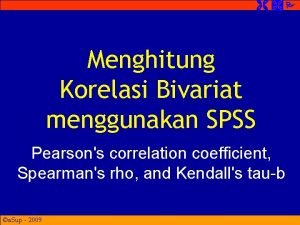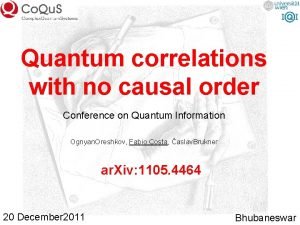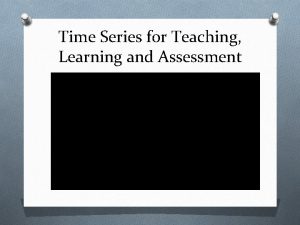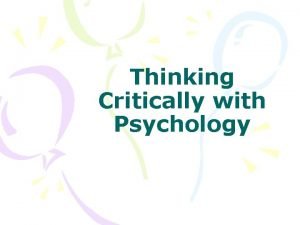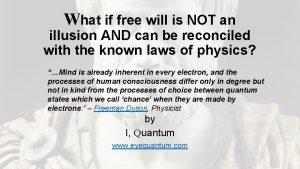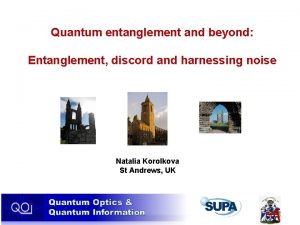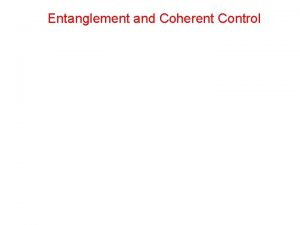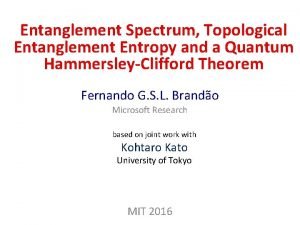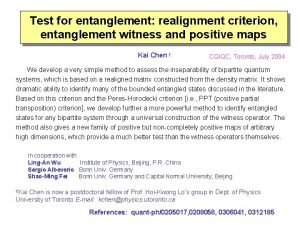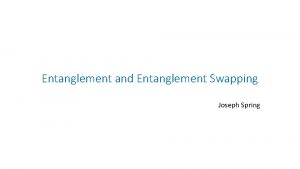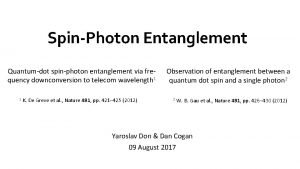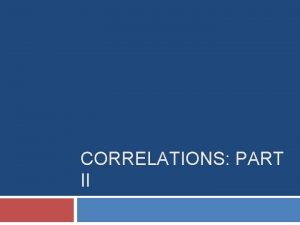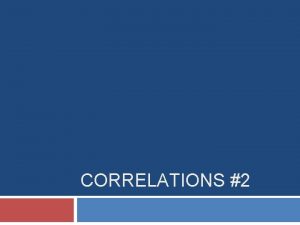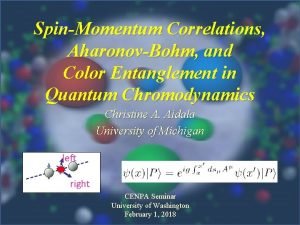Erasing correlations destroying entanglement and other new challenges


![Everything is a resource qubit [q!q] |0 i. A!|0 i. B and |1 i. Everything is a resource qubit [q!q] |0 i. A!|0 i. B and |1 i.](https://slidetodoc.com/presentation_image_h2/12c752cb89aad772796cff2ec02402f3/image-3.jpg)
![Undoing things is also a resource reversal [q!q]y = [qq]y [q!qq]y = = meaning Undoing things is also a resource reversal [q!q]y = [qq]y [q!qq]y = = meaning](https://slidetodoc.com/presentation_image_h2/12c752cb89aad772796cff2ec02402f3/image-4.jpg)








- Slides: 12

Erasing correlations, destroying entanglement and other new challenges for quantum information theory quant-ph/0511219 Aram Harrow, Bristol Peter Shor, MIT QIP, 19 Jan 2006

outline • General rules for reversing protocols • Coherent erasure of classical correlations • Disentangling power of quantum operations
![Everything is a resource qubit qq 0 i A0 i B and 1 i Everything is a resource qubit [q!q] |0 i. A!|0 i. B and |1 i.](https://slidetodoc.com/presentation_image_h2/12c752cb89aad772796cff2ec02402f3/image-3.jpg)
Everything is a resource qubit [q!q] |0 i. A!|0 i. B and |1 i. A!|1 i. B ebit [qq] the state (|0 i. A|0 i. B + |1 i. A|1 i. B)/p 2 cbit [c!c] |0 i. A! |0 i. B|0 i. E and |1 i. A!|1 i. B|1 i. E cobit [q!qq] |0 i. A! |0 i. A|0 i. B and |1 i. A!|1 i. A|1 i. B resource inequalities super-dense coding: [q!q] + [qq] > 2[c!c] 2 [q!qq] In fact, [q!q] + [qq] = 2 [q!qq]
![Undoing things is also a resource reversal qqy qqy qqqy meaning Undoing things is also a resource reversal [q!q]y = [qq]y [q!qq]y = = meaning](https://slidetodoc.com/presentation_image_h2/12c752cb89aad772796cff2ec02402f3/image-4.jpg)
Undoing things is also a resource reversal [q!q]y = [qq]y [q!qq]y = = meaning [qÃq] (relation between time-reversal and exchange symmetry) -[qq] (disentangling power) [qÃqq] (? ) |0 i. A |0 i. B! |0 i. A and |1 i. A |1 i. B!|1 i. A (coherent erasure? ? )

What good is coherent erasure? a|0 i. A + b|1 i. A ! a|0 i. A|0 i. B + b|1 i. A|1 i. B (using [q!qq]) ! a|0 i. B + b|1 i. B (using [qq!q]) = [q!qq] + [qq!q] > [q!q] = [qq!q] > [q!q] - [q!qq] = [q!qq] - [qq] entanglement-assisted communication only = ([q!q] - [qq]) / 2 In fact, these are all equalities! (Proof: reverse SDC. ) Alice Bob |xi |yi E (I X Z )|Fi x y X Z |Fi |xi |yi

application to unitary gates U is a bipartite unitary gate (e. g. CNOT) Known: U > C[c! c] implies U > C[q!qq] Time reversal means: Uy > C [qÃqq] = C [qqÃq] - C [qq] Corollary: If entanglement is free then C!E(U) = CÃE(Uy).

The quest for asymmetric unitary gate capacities Problem: If U is nonlocal, it has nonzero quantum capacities in both directions. Are they equal? Yes, if U is 2£ 2. No, in general, but for a dramatic separation we will need a gate that violates time-reversal symmetry. the construction: (Um acts on 2 m £ 2 m dimensions) Um|xi. A|0 i. B = |xi. A|xi. B for 0 6 x < 2 m Um|xi. A|yi. B = |xi. A|y-1 i. B for 0 < y 6 x < 2 m Um|xi. A|yi. B = |xi. A|yi. B for 0 6 x < y < 2 m

et voilà l’asymétrie! Um|xi. A|0 i. B = |xi. A|xi. B for 0 6 x < 2 m Um|xi. A|yi. B = |xi. A|y-1 i. B for 0 < y 6 x < 2 m Um|xi. A|yi. B = |xi. A|yi. B for 0 6 x < y < 2 m Um > m[q!qq] Upper bound by simulation: m[q!qq] + O((log m)(log m/e)) ([q!q] + [qÃq]) & Um Similarly, Umy > m[qÃqq] and m[qÃqq] + O((log m)(log m/e)) ([q!q] + [qÃq]) & Umy Meaning: Um ¼ m [q!qq] and Umy ¼ m [qÃqq] (almost worthless w/o ent. assistance!)

disentanglement clean resource inequalities: means that a n can be asymptotically converted to b n while discarding only o(n) entanglement. (equivalently: while generating a sublinear amount of local entropy. ) clean Example: [q!q] > [qq] and [q!q] > -[qq] clean Example: Um > m[qq], but can only destroy O(log 2 m) [qq] clean Umy > -m[qq], but can only create O(log 2 m) [qq]

You can’t just throw it away Q: Why not? A: Given unlimited EPR pairs, try creating the state Hayden & Winter [quant-ph/0204092] proved that this requires ¼n bits of communication.

more relevant examples Entanglement dilution: |yi. AB is partially entangled. E = S(y. A). |Fi n. E+o(n)!|yi n Even |Fi 1!|yi n requires W(n½) cbits (in either direction). OR a size O(n½/e) embezzling state [q-ph/0205100, Hayden-van Dam] Quantum Reverse Shannon Theorem for general inputs Input r n requires I(A; B)r [c!c] + H(N(r)) [qq]. [Bennett, Devetak, Harrow, Shor, Winter] Superpositions of different r n mean consuming superpositions of different amounts of entanglement: we need either extra cbits, embezzling, or another source of entanglement spread.

summary • new ideas • coherent erasure • clean protocols READ ALL ABOUT IT! • entanglement spread quant-ph/0511219 • new results • asymmetric unitary gate capacities • QRST and other converses • new directions • formalizing entanglement spread • clean protocols involving noisy resources (cbits? )
 Eraser crumbs and debris from the drafting table.
Eraser crumbs and debris from the drafting table. Is erasing a pencil mark a physical or chemical change
Is erasing a pencil mark a physical or chemical change Eraser shield definition
Eraser shield definition Mining frequent patterns associations and correlations
Mining frequent patterns associations and correlations Closed patterns and max-patterns
Closed patterns and max-patterns Mining frequent patterns associations and correlations
Mining frequent patterns associations and correlations Quantum computing and the entanglement frontier
Quantum computing and the entanglement frontier Bivariat
Bivariat Quantum correlations with no causal order
Quantum correlations with no causal order Spurious correlations
Spurious correlations Thinking critically
Thinking critically What is time
What is time Firefighter entanglement prop
Firefighter entanglement prop



